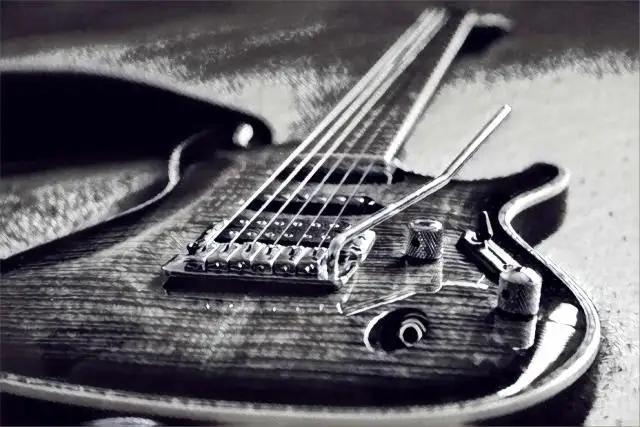The guitar is a pretty unique instrument. With a simple twist of the tuning pegs, you can completely change the way it sounds, transforming the instrument into something almost completely new.
Open tunings offer a whole new way to play and hear guitar. Think about the beautiful, deep sounds Joni Mitchell gets, or the raw, powerful blues riffs of Robert Johnson. These legends used open tunings to create their iconic songs. Even rockers like Keith Richards spun some magic with open G tuning, giving us some of the most famous riffs in rock history.
Today, artists like Kaki King and Derek Trucks keep exploring these tunings, pushing what the guitar can do even further.
In this guide, we’ll explore all there is to know about open tunings to see how they can spice up your playing. Whether you’re just starting out or you’ve been playing for years, open tunings can have a profound impact on the way you look at the guitar. Let's dive in!
What Is An Open Tuning?
So, what exactly is an open tuning?
In the simplest terms, an open tuning adjusts the pitches of your guitar strings so that when you strum them open (without pressing down any frets), they form a chord. This means you can play a full chord without needing to finger all the strings, which opens up a world of possibilities for easier playing and unique harmonic textures.
Different open tunings have found their niches across various music genres.
For example, the open G tuning has long been a staple in blues and rock. It was a favorite of the blues legend Robert Johnson and was heavily used by The Rolling Stones. On the flip side, folk musicians often gravitate towards open D or open C to tap into softer, more melodic sounds suited to storytelling.
Let's kick things off by discussing some of the most popular open tunings out there.
Open E Tuning
Open E tuning is one of the first open guitar tunings we'll discuss, as it's also one of the most popular. I personally love open E tuning, as it opens up the guitar in a powerful way without having to make many alterations.
In this tuning, the strings are tuned to E, B, E, G#, B, E - from the lowest to the highest string.
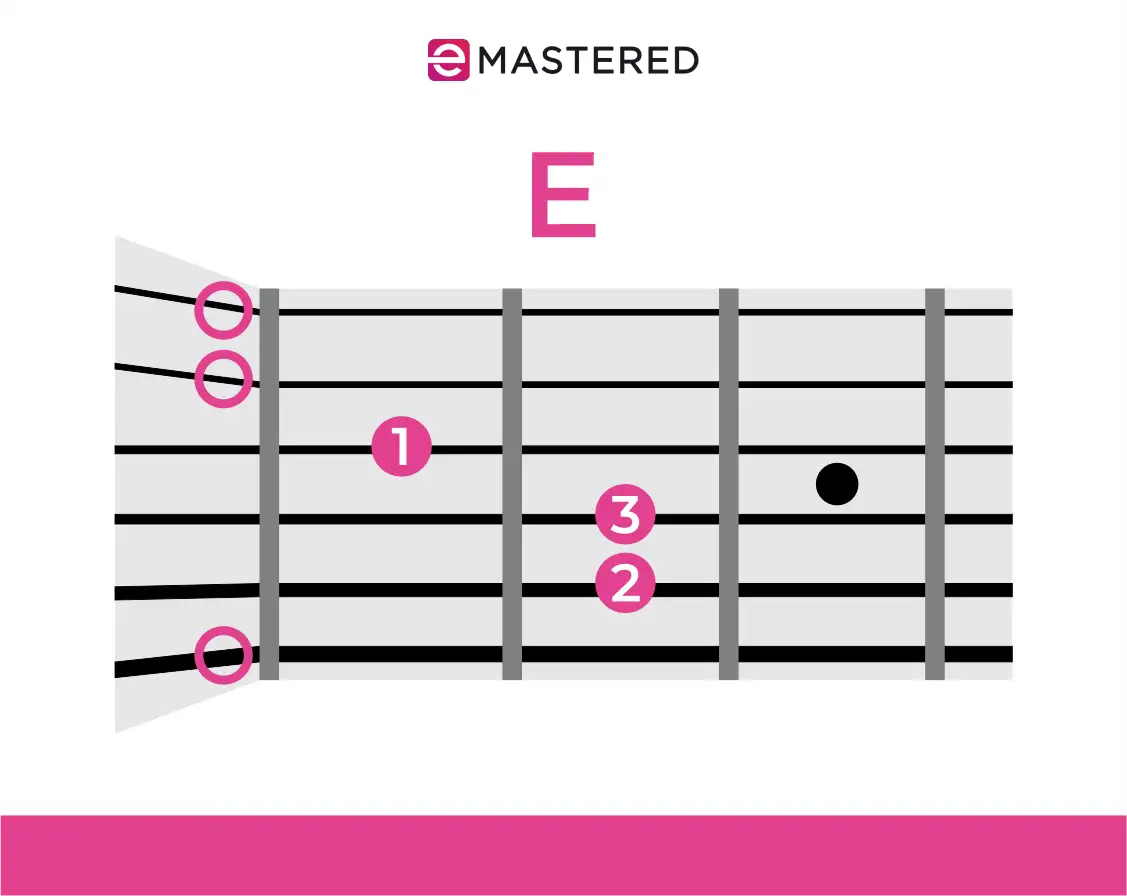
This arrangement mirrors the notes of the E major "cowboy" chord in standard tuning. To play a standard E cowboy chord, you typically place your index finger on the first fret of the G string (making it a G#), your middle finger on the second fret of the A string (turning it into a B), and your ring finger on the second fret of the D string (making it an E).
When strummed, the notes, from low to high, would be E, B, E, G#, B, E.
To convert from standard tuning to open E, you’d tune the A up to B, the D up to E, and the G up to G#. It’s a straightforward shift, yet it dramatically shifts the way in which you can play your instrument.
Once in open E tuning, you can easily play major chords all up and down the neck just by barring across all six strings at any fret. For example, barring at the third fret gives you a G major chord, while barring at the fifth fret gives you an A major.
Open E is a favorite among rock and blues guitarists. It was used in "Jumpin' Jack Flash" by The Rolling Stones for the beginning guitar part. Richards tuned down his Gibson Hummingbird to get that slack sound at the start.
"She Talks to Angels" by The Black Crowes and "Gimme Shelter" by The Rolling Stones are also in open E tuning, and you can hear the same rich, full-bodied sound that's instantly recognizable. Some other good examples of open E tuning include Bruce Springsteen's "Born to Run" and Radiohead's "Street Spirit (Fade Out)."
It's also worth noting that open E tuning is a go-to for slide guitar players. Duane Allman of the Allman Brothers Band is probably one of its most famous proponents. Allman used open E for his legendary slide guitar solos in "Statesboro Blues" and "Dreams."
He often spoke about how the tuning allowed him to express his musical ideas more freely, noting that the open E gave him the freedom to move anywhere he wanted, with all the necessary notes available right under his slide.
Open D Tuning
One of the next most popular open tunings after open E is open D tuning. Like open E, open D is built on the same basic structure but is tuned a whole step down. The strings in open D are tuned to D, A, D, F#, A, D , from the lowest to the highest string.
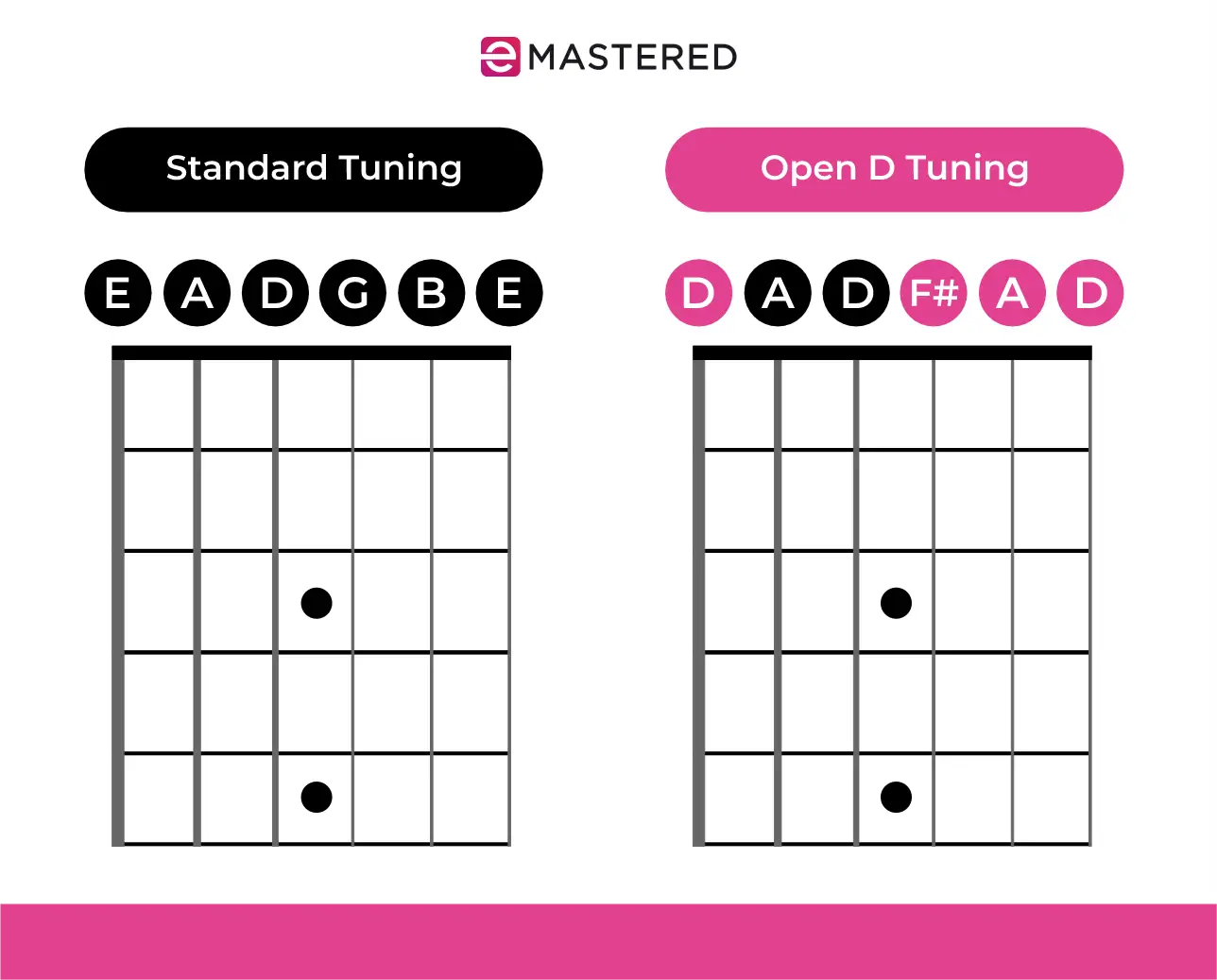
To get to open D from standard tuning, you’ll need to lower the low E string down to D, the A string remains the same, the D string remains the same, the G string is lowered to F#, the B string is lowered to A, and the high E string is lowered to D.
Open D tuning is also known by its historical name, the Vestapol system . This term originates from the 19th century and is named after a popular tune called "The Siege of Sevastopol" (commonly misspelled as "Vestapol"), which was frequently played in this tuning. The Vestapol system became a foundational tuning for early American folk and blues music, allowing for those rich, resonant open chords that provided a full, ringing sound ideal for fingerpicking and slide guitar.
Like open E tuning, open D has been used in numerous popular songs.
One of the most popular examples might be Joni Mitchell's "Big Yellow Taxi," where the open D tuning provides the song's bright and jangly backdrop.
Neil Young’s "The Needle and the Damage Done" also features the tuning, which gives it that reflective feel, and slide guitar legend Elmore James used it extensively throughout his career, one of my favorite songs of which is "Dust My Broom."
For a more modern example, check out Bon Iver's "re: Stacks."
Open A and G Tuning
I put open A and open G tunings together, as they are both based on the same system of tuning as open E and D, giving us that rich, resonant major chord sound when strumming the open strings.
These tunings are part of what’s often referred to as "Spanish tunings," a term that dates back to 19th-century guitarists who used these tunings to emulate the sounds of Spanish flamenco guitar.
Open A tuning tunes the strings to A, E, A, C#, E, A, from the lowest to the highest string. To get to open A from standard tuning, you need to raise the D string to E, the G string to A, and the B string to C#.
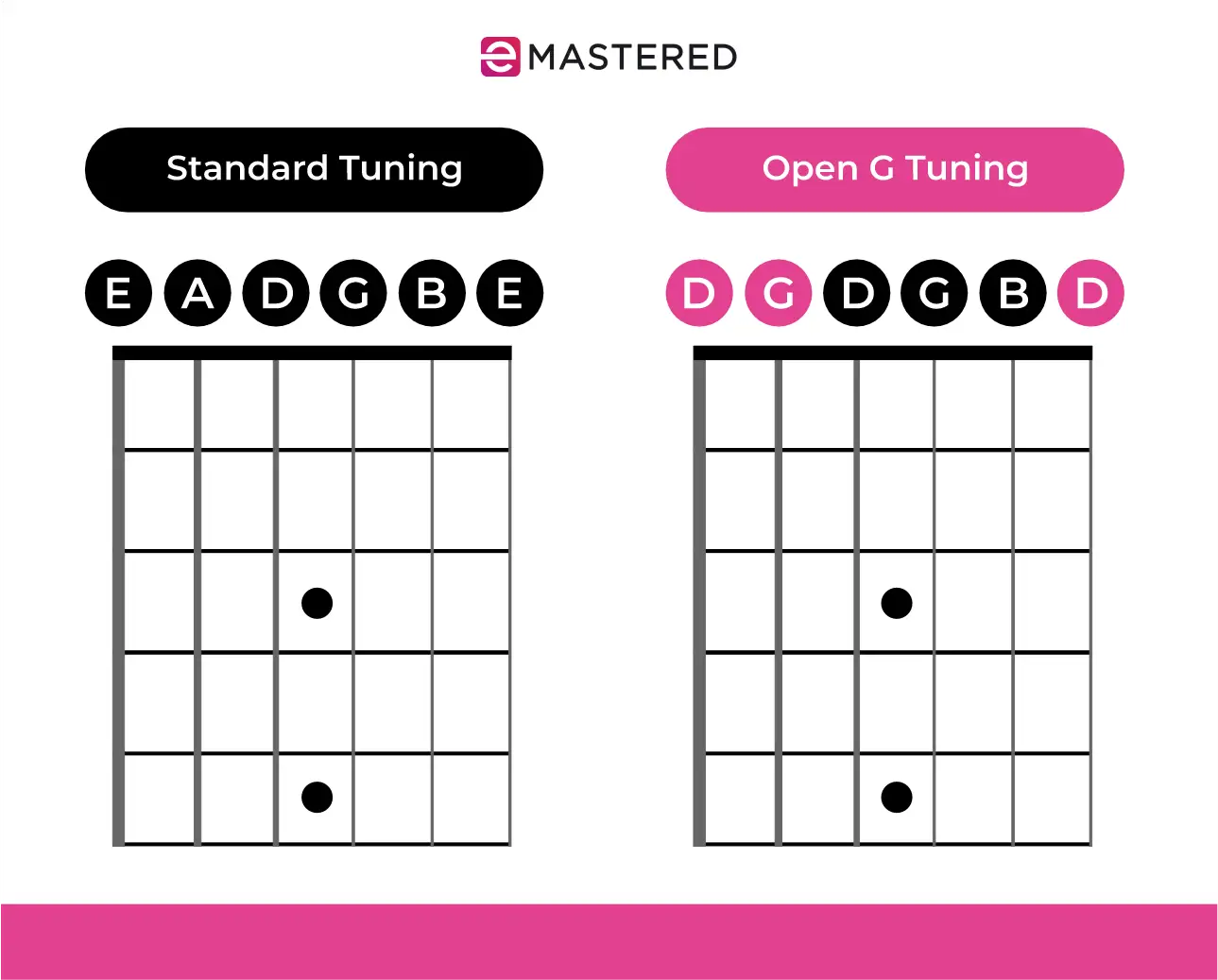
Open G tuning , which is arguably more popular than open A, is often favored for its rich tonal quality. The strings are tuned to D, G, D, G, B, D, from the lowest to the highest string. To get to open G from standard tuning, you lower the low E string to D, the A string to G, and the high E string to D.
Open G tuning is particularly well-known because it’s been used by many legendary guitarists. For instance, The Rolling Stones' Keith Richards famously used open G tuning for songs like "Honky Tonk Women" and "Brown Sugar."
Another iconic example is Led Zeppelin’s "Bron-Yr-Aur Stomp," which is easily one of my favorite tracks to showcase the rich, versatile sound of open G.
As with open C and D tunings, you can barre chords with your pointer finger all the way up and down the strings to get major chords. However, with open G tuning, I often find myself keeping open strings in my riffs and melodies to create a droning effect.
For instance, you can create a bluesy sound by playing a slide riff on the higher strings while letting the lower strings ring open.
Alternate Tunings
Beyond the standard open tuning options we have above, there are near-endless alternate tunings you can experiment with. Let's look at some of the most popular.
Drop D Tuning
Drop D tuning is one of the most widely used alternate tunings in rock history. Its popularity likely stems from the fact that it's so simple to get to. The heavy sound it produces has made it a go-to tuning for countless rock and metal guitarists, especially when paired with distortion.
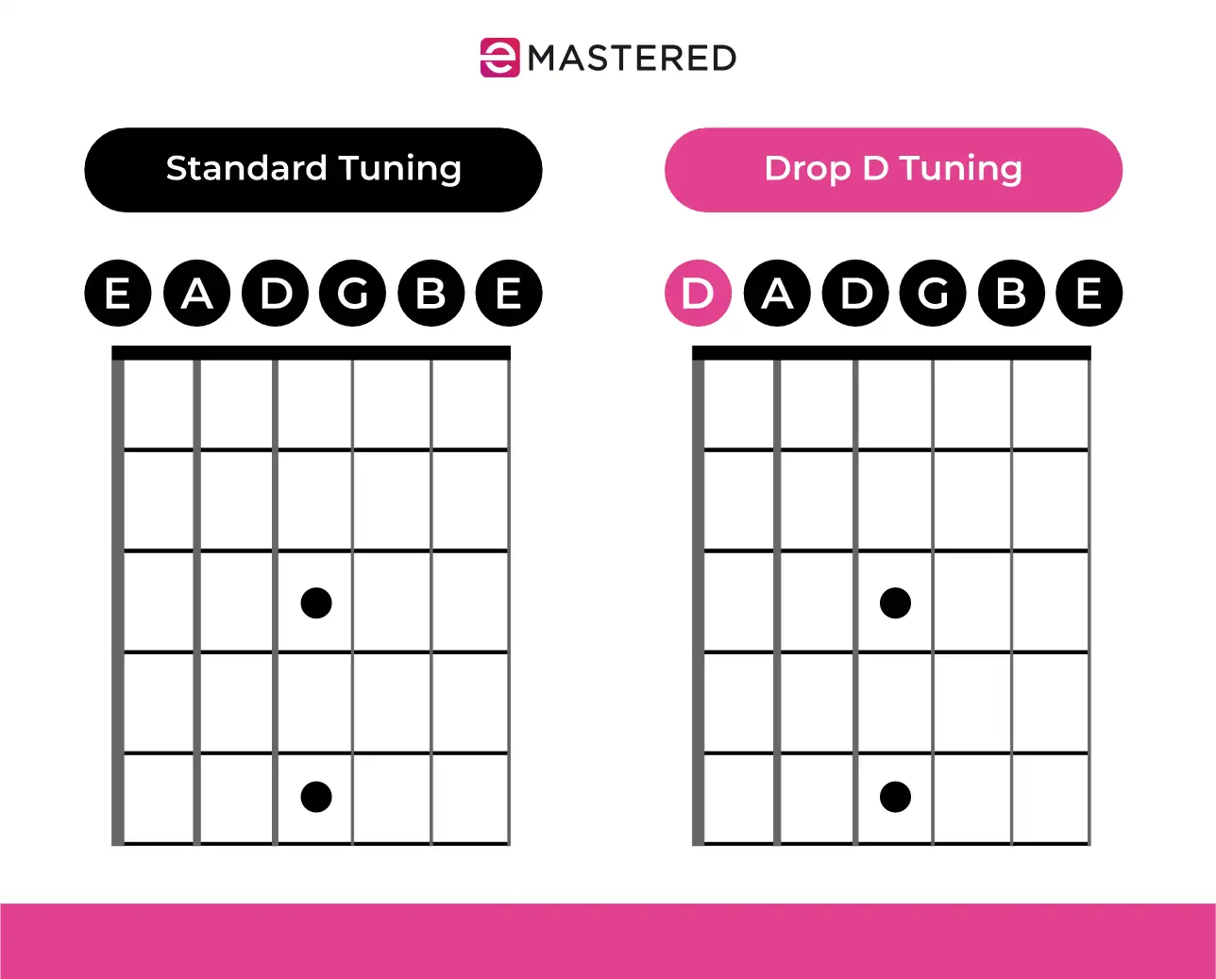
Getting to drop D tuning from standard guitar tuning is easy. Starting from standard tuning, you only need to lower the pitch of the low E string down one whole step to D. This adjustment changes the tuning of the strings to D, A, D, G, B, E, from the lowest to the highest string.
By doing so, you get a deep, resonant low D note that adds a fuller sound to your chords and riffs and extends the range of your guitar.
Drop D tuning makes power chords really easy to play, as all you have to do is barre the lowest three strings with one finger, making it perfect for fast, aggressive chord changes and heavy riffs.
"Killing in the Name" is just one of the many Rage Against the Machine songs that use drop D.
Some of the others that I can think of right off the top include "Everlong" by Foo Fighters and "Moby Dick" by Led Zeppelin.
If you want to take things even further, you can use double-drop D tuning. While it's also great for heavy music, it's one of my favorite tunings for folk-style acoustic guitar fingerpicking.
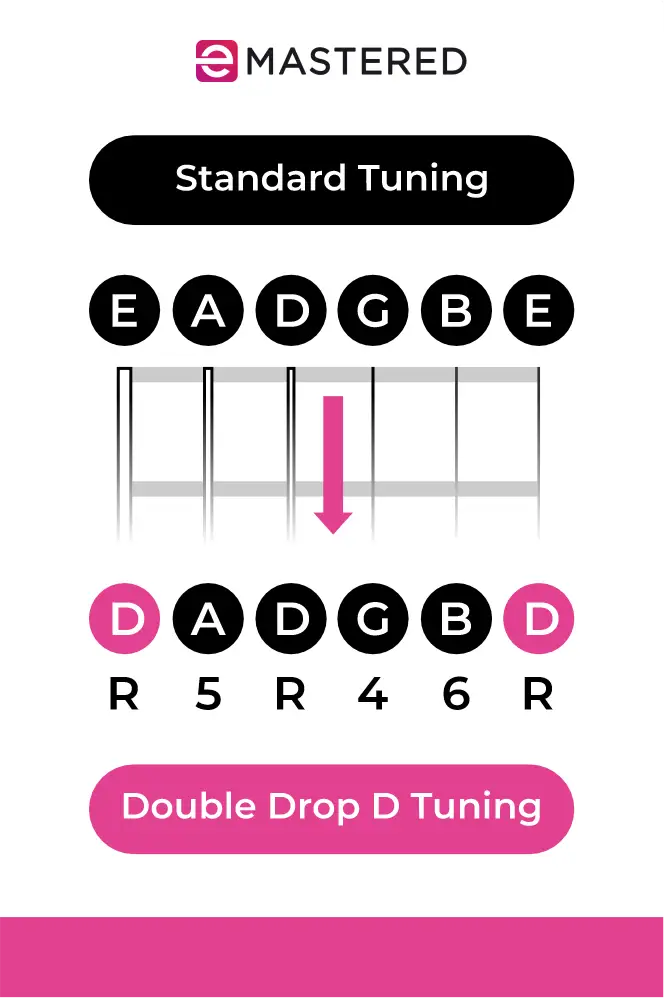
To get from regular drop d to double drop D tuning, all you have to do is tune the high E string down to a D.
Some of the most popular double drop D tunes include "Cinnamon Girl" by Neil Young and "Going to California" by Led Zeppelin.
DADGAD
Another popular alternate tuning for folk and rock music is DADGAD. It's also wildly popular in traditional Celtic music, as it has a rich, open sound that's perfect for fingerpicking.
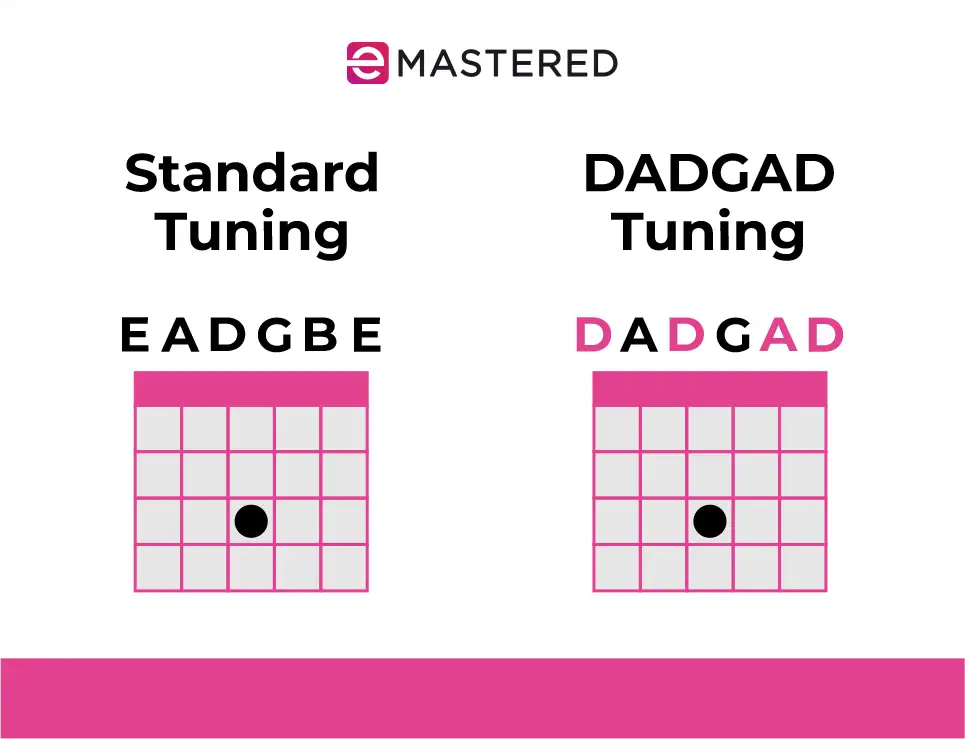
Starting from standard tuning, you lower the low E string down to D, the B string down to A, and the high E string down to D. This adjustment changes the tuning of the strings to D, A, D, G, A, D, from the lowest to the highest string.
If you were to strum the open strings in this alternate tuning, you'd get a modal Dsus4 chord.
I love DADGAD tuning, as it maintains the familiar feel of standard tuning for the middle strings, though gives you altered outer strings for an interesting harmonic voice.
Some of my favorite tracks that use this alternate tuning include "Kashmir" by Led Zeppelin, "Orion" by Metallica, and "Circle" by Edie Brickell & New Bohemians.
CGDGAD
CGDGAD is another modal alternate tuning. Even more so than the DADGAD tuning above, CGDGAD is a prime "Celtic tuning," particularly popular in acoustic folk music.
With the low C, you can produce deep, droning bass notes that act as the foundation for your sparkling high notes.
You still get the familiar intervals of standard tuning for the middle strings, while the altered outer strings extend the range of the guitar and give you more to work with.
While Kaki King uses many alternate tunings in her music, CGDGAD seems to be one of her favorites. It can be heard in albums like "How I Got Lost" and "Dreaming of Revenge." You can also hear this tuning in many Celtic fingerstyle arrangements by Jim Tozier. "Slane" is one of my absolute favorites!
CGDGCD
Popularized and named by Scottish guitarist and composer Steve Baughman, DGCGCD tuning is often referred to as "Orkney tuning," as he named it after the Orkney Islands, a group of islands located off the northeastern coast of Scotland.
Baughman chose this name as a tribute to the mystical, haunting beauty of the islands, which inspired the tuning’s unique sound. It's very similar to the modal five-string tuning we hear on the banjo. Guitarists like Tony McManus and Martin Simpson often use this alternate tuning.
As you may have guessed, Orkney tuning is particularly well-suited for Celtic and folk music.
Starting from standard tuning, you tune the lower E string down to C, the A string down to G, the D string remains the same, the G string remains the same, the B string up to C, and the high E string down to D. This adjustment changes the tuning of the strings to C, G, C, G, C, D, from the lowest to the highest string.
EEEEBE
Moving into more unconventional alternate tunings, we have EBEEBE tuning, which is also often referred to as the Bruce Palmer Modal Tuning. It's one of the best tunings for droning soundscapes and atmospheric music.
The tuning was named after Buffalo Springfield bassist Bruce Palmer, who popularized it with tracks like "Judy Blue Eyes."
Getting there can be a bit weird, as starting from standard tuning, you have a lot to adjust. Keep the lower E string the same, tune the A string down to E, the D string up to E, the G string down to E, the B string remains the same, and the high E string remains the same.
FACGCE
FACGCE tuning is often referred to as "American Football tuning," which comes from the band American Football, who extensively used this tuning in their music. The open tuning creates an open F9 chord that provides a strangely happy yet lush and complex sound. For a while, it was a staple in emo and math rock. This tuning was popularized by bands seeking to create intricate, emotive soundscapes with rich harmonic overtones.
Some of my favorite guitarists known for using this open tuning include Yvette Young of Covet and Tim Collis of This Town Needs Guns.
BEADF#B
BEADF#B tuning, or B standard, is an alternate tuning that drops the guitar's pitch.
This tuning is particularly well-suited for baritone guitars, which are designed to handle lower tunings with their longer scale length. If you don't have a baritone guitar, you may need to make some adjustments to ensure proper intonation and playability. Using heavier gauge strings can help maintain string tension and avoid a floppy feel, while adjusting the truss rod and intonation on your guitar to accommodate the lower tension and ensure that the notes stay in tune across the fretboard.
Stephen Carpenter of Deftones is well-known for his downturned riffs and is a big proponent of this low tuning. Beyond Deftones, some of my favorite tracks that use this tuning include "953" by Black Midi and "Searching With My Good Eye Closed" by Soundgarden.
EBDGAD
Finally, we get to one of the strangest alternate tunings that also happens to be one of my favorites when I'm feeling experimental — the EBDGAD tuning, often referred to as "Crosby tuning."
It's great for folk, blues, and experimental music and was popularized by David Crosby of Crosby, Stills & Nash.
Starting from standard tuning, you adjust the strings as follows: keep the lower E string the same, tune the A string up to B, the D string remains the same, the G string remains the same, the B string down to A, and the high E string down to D.
A World of Possibilities Await
This guide to open and alternate tunings is just the tip of the iceberg, as there are truly endless guitar tunings to explore. Each tuning comes with its own distinct characteristics, opening up new avenues for creativity and expression.
To start experimenting with these tunings, you don’t need much more than curiosity and a willingness to explore. Begin by retuning your guitar to one of the tunings we've discussed, and spend some time playing familiar chords and melodies. Notice how the new tuning changes the sound and feel of your playing. You can also look up songs that use these tunings and learn how your favorite artists make the most of them.
So pick up your guitar, twist those tuning pegs (carefully if you're tuning certain strings higher), and let your creativity soar. The possibilities are endless, and the adventure is just beginning. Happy playing!


